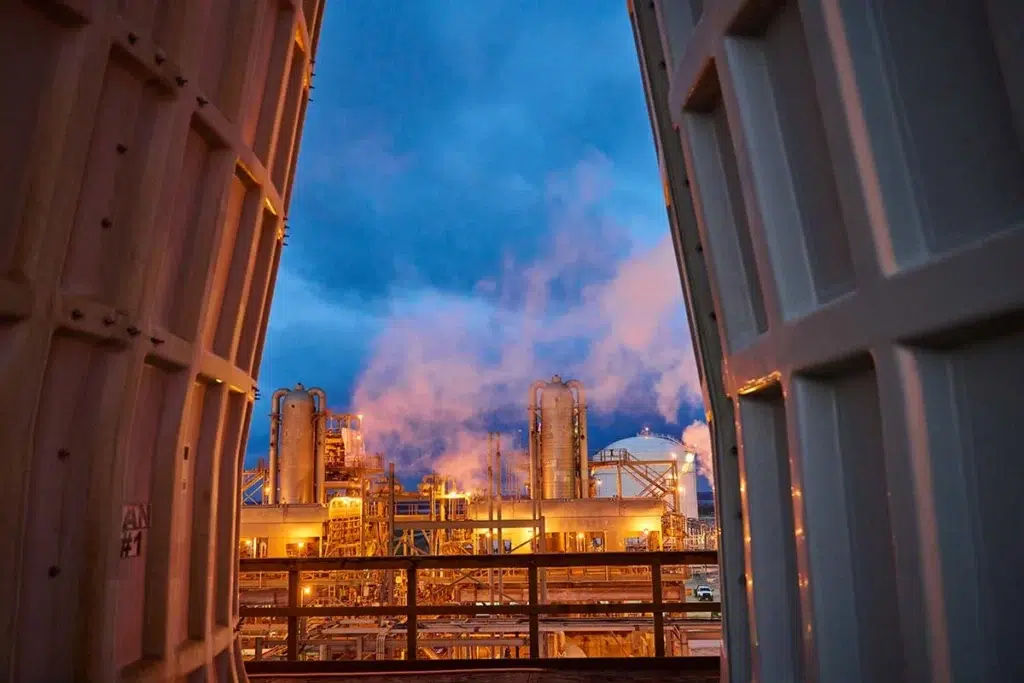Transport is responsible for 21% of global carbon dioxide emissions and achieving Net Zero for the sector by 2050 will require the industry to reduce emissions by more than 3% a year until 2030. With a complex, globally connected sector like transport, there’s no single solution to decarbonization. Fortunately, there are different routes we can take, a few of which are available today.

Starting with immediate transitional tools, ‘drop-in’ solutions that can make use of existing production and logistics infrastructure, such as lower carbon and renewable hydrogen fuels like methanol and ammonia, play a critical role. Green methanol is blended with traditional gasoline in the fuel pool today, offering a more than 60% greenhouse gas reduction for road transport, which is essential to bridge the transition while the path to EV is still developing.
And these lower carbon alternatives also provide a long-term solution for transport that will always be hard to electrify, like long distance shipping. When compared with conventional marine fuels, green methanol can reduce carbon dioxide emissions by 60-95%, reduce nitrogen oxide emissions by 60-80% and almost completely eliminate sulphur oxide and particulate matter emissions.
Growing demand
2023 has been a significant year for catalyzing change in the marine sector. We saw the completion of the maiden voyage of the world’s first green methanol containership, which was fueled by OCI HyFuels green methanol. Following this milestone achievement, we expect to see even more activity in 2024, particularly in anticipation of upcoming regulations including the EU’s ETS and FuelEU for maritime.
The current projected order book for dual-fuelled methanol vessels is around 250 ships, which would translate to demand above 7 million tonnes by 2028. At around this time, ammonia will become more prevalent as a shipping fuel as the technology and infrastructure scales, with anticipated demand for ammonia as a shipping fuel of 40 million tonnes per annum by 2035, and we expect both methanol and ammonia to be used well into the 2030s and beyond.
But challenges remain in delivering a fuel transition of the scale needed to make a real impact on the industry’s emissions. Looking at marine again, the International Maritime Organization (IMO) has an opportunity to create global change and could replicate the example set by the EU to reach its own ambitious targets. But details about how it will do this are still to come.
Meanwhile, for all fuels markets, it is essential that supply meets demand.

Scaling supply
Leveraging existing infrastructure to accelerate decarbonization is particularly important to scale supply. At our facilities, we methodically scale up renewable production of methanol and ammonia on a cost competitive and agile basis.
In September we announced that we are doubling our green methanol capacity in the US, growing our existing leadership position as the world’s largest producer of green methanol. Our approach is to use a mix of renewable feedstocks including renewable natural gas (RNG), green hydrogen and other over the fence feedstock partnerships.
We also announced a new green hydrogen supply agreement with New Fortress Energy’s ZeroParks for green ammonia production at our existing facility in Texas, scaling up our green ammonia capacity there to approximately 160,000.
Because we take incremental steps with our production, this allows us to move on a quicker timeline than building a greenfield facility, which, in turn, accelerates upstream and downstream value chain decarbonization. Mechanisms like the Mass Balance system – tracing renewable inputs and matching these quantities with outputs in an enclosed and connected energy system – enables this practical approach to supply scale up via existing infrastructures. Such mechanisms are vital for renewable and low carbon fuels production to continue to grow.
Beyond pioneers to progress
If we want to have a wholesale transition to lower carbon and renewable fuels, we need pioneers to join us in investing in projects that scale up the global supply, but we also need to see industry-wide progress. A practical approach, with everyone taking bites of the apple, will be essential to achieve the end goal of transition.
Practical systems like mass balance and global regulatory support will be essential in making both of those things happen. It is no coincidence that three of our significant supply scale up projects are in the US. The introduction of the landmark Inflation Reduction Act (IRA) with its clear, simple framework and mechanisms like the section 45V Clean Hydrogen Production Tax Credit, has provided the confidence that has underpinned decisions like our recent agreement with New Fortress Energy. Increasing demand with regulations like the EU’s REDIII will provide the confidence for the whole industry to make change together.
We need to see industry and regulators come together, setting, and then taking advantage of that regulation once in place, building and adapting infrastructure and agreeing offtakes to secure the market for low carbon and renewable fuels. It was encouraging to see the support from both public and private sector leaders for The Public-Private Action Statement on Cross-Border Trade in Hydrogen and Derivatives launched at COP28, but we need to see that support catalyzed into action.
Incremental change by incumbents and pioneers alone will not be enough to solve the climate crisis. 2024 needs to be a watershed year for the fuel transition, and collaboration across the whole ecosystem including between the public and private sectors, is the only way we will get there.

This article was first published in Tank Storage Magazine in February 2024.